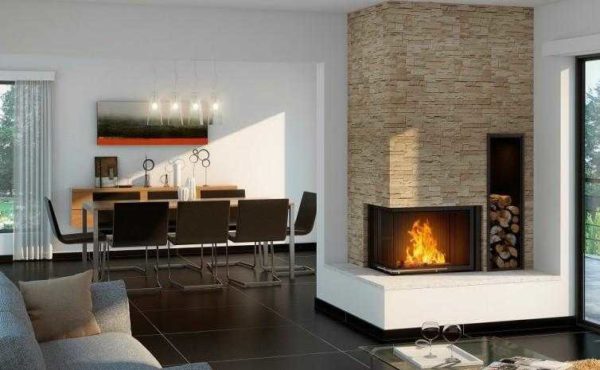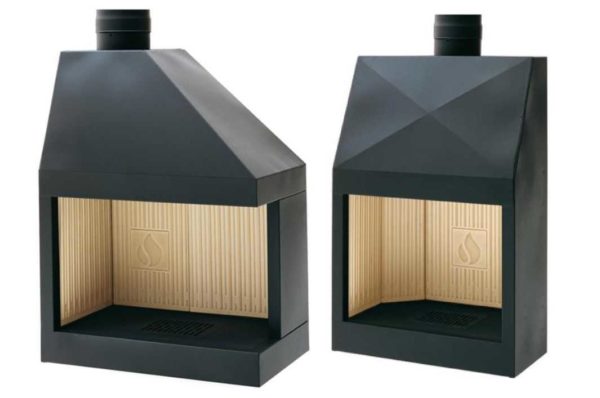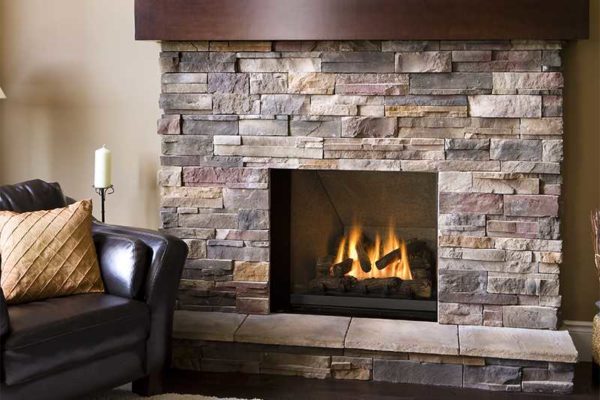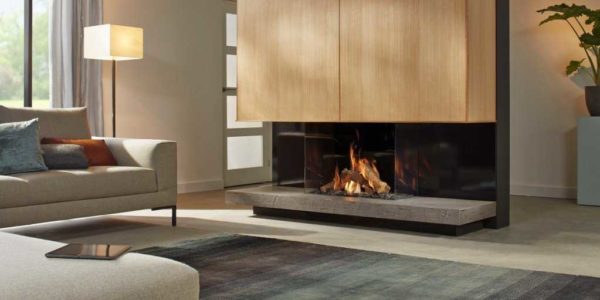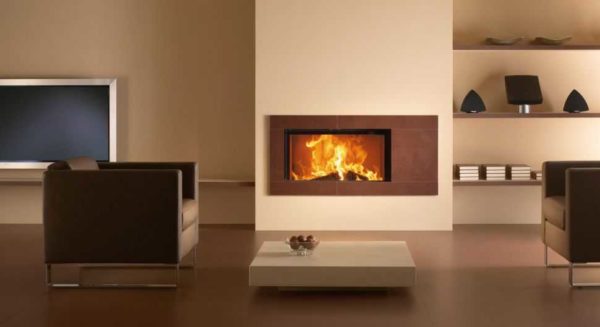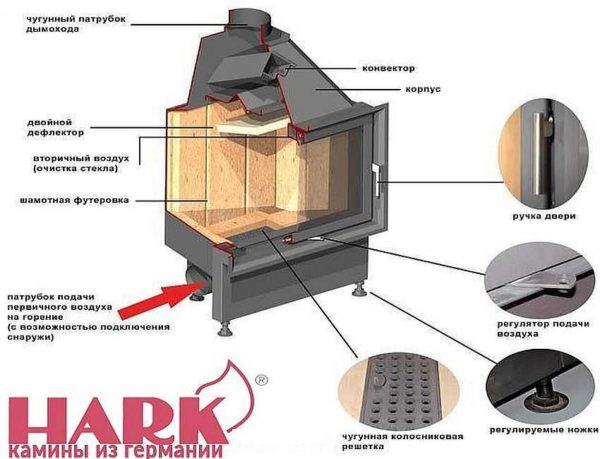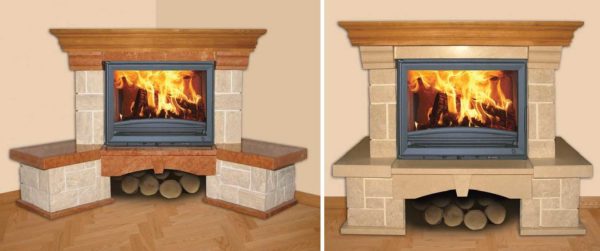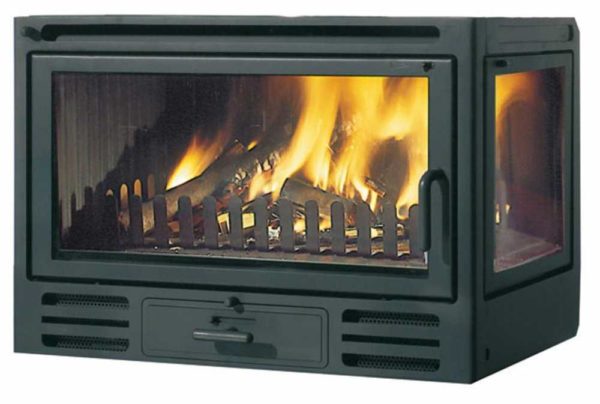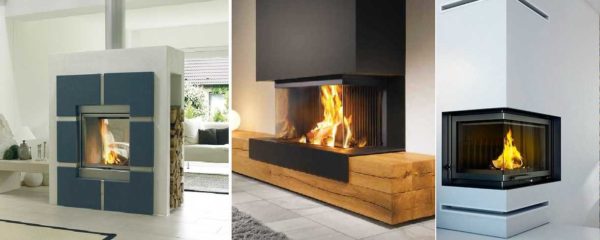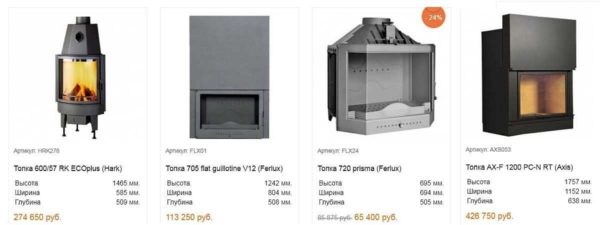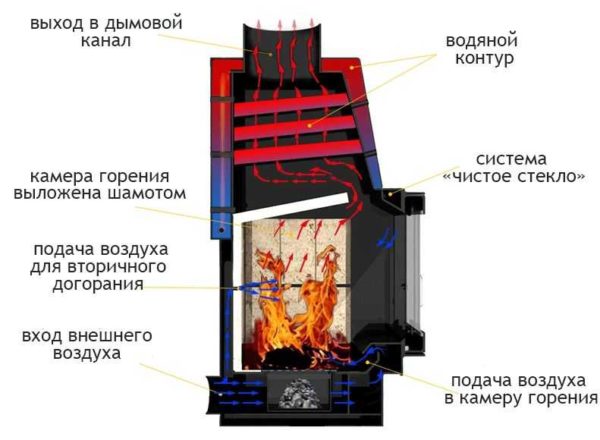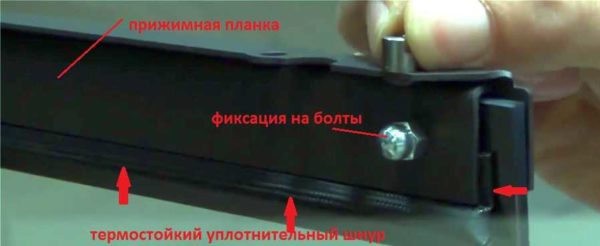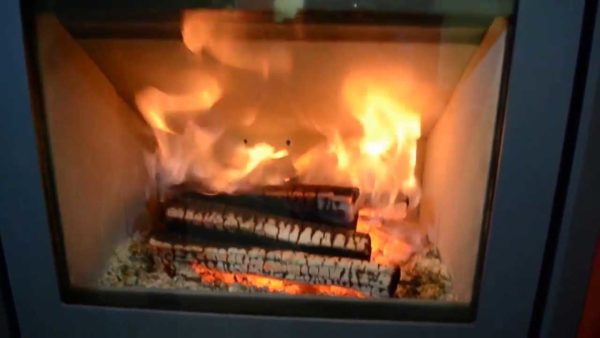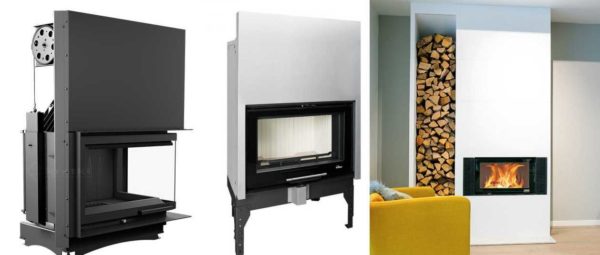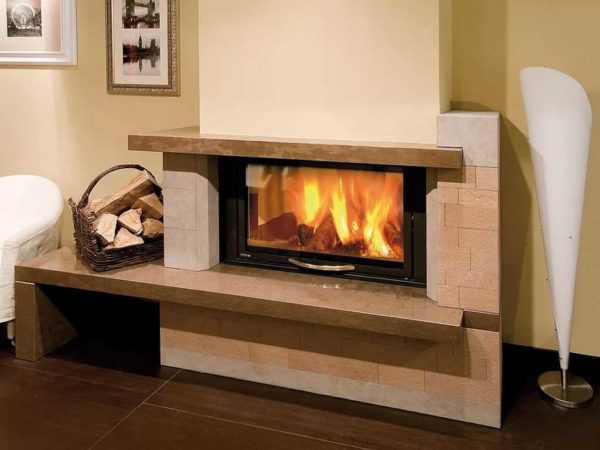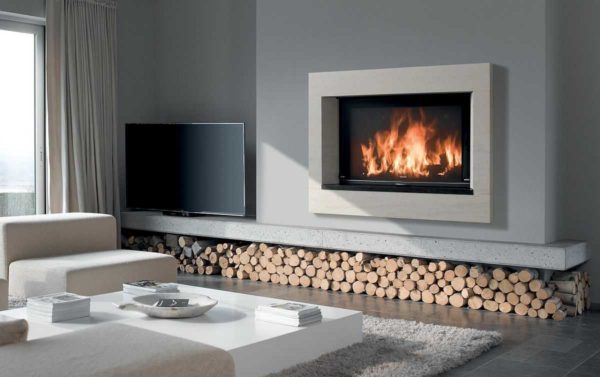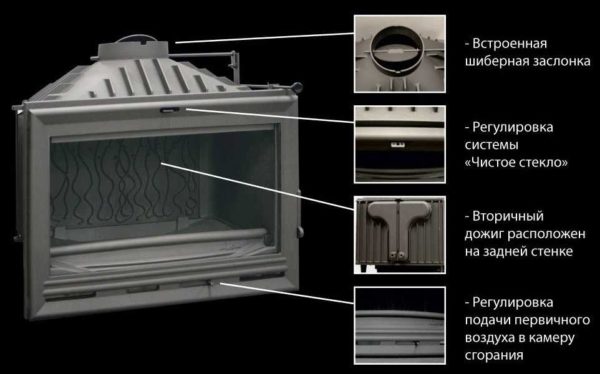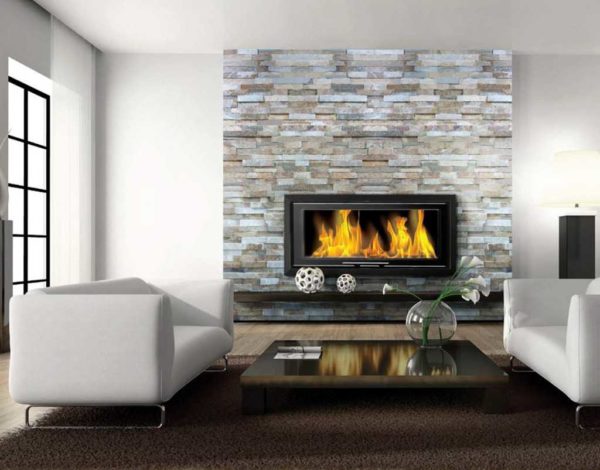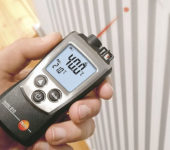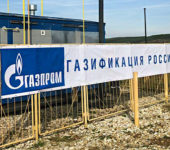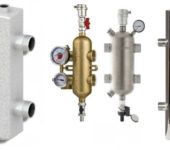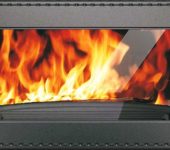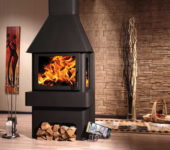Fireplace inserts: what is it and how to choose
Today, making a fireplace is not as difficult as a couple of decades ago. It is not necessary to lay it out of brick - there are metal inserts that need to be arranged accordingly. This insert is called a fireplace insert or a fireplace insert. Can be made of heat-resistant steel and cast iron. What they are, how to choose - we look further.
The content of the article
Which fireplace insert is better: open or closed
In general, a fireplace as a heating element is effective in a well-insulated house. Then it can be the main and even the only source of heat. But it is not at all easy - to make a full-fledged heating based on a fireplace. In any case, first you have to decide - you need an open or closed fireplace insert. Open - very similar to a traditional hearth, but modern options are made of cast iron or heat-resistant steel. And there is no need to lay it out of bricks.
A closed fireplace insert is also made of metal, but differs in that it is airtight - it has a tightly fitted door that separates the fireplace from the room. In addition to the appearance, there are many more features. They will help you make a choice.
Open fireplace inserts
When we think about the fireplace, a picture appears: a hearth, firewood crackling, tongues of flame dancing. Everything is so, but let's appreciate all the delights of such a heater:
- Free burning is a big consumption of firewood. The efficiency of open furnaces is only about 10-15%. Despite the fact that it is done correctly, it has a well-functioning chimney. That is, only a tenth of the heat received from burning wood goes into the room. The rest just flies into the pipe.
- An open fire is beautiful. Yes, but it is impossible to regulate the combustion. Firewood always burns "at full capacity".
- Open firebox - soot flies not only into the chimney, but also into the room. After a couple of years of occasional use, the ceiling and walls will be gray. Don't believe me? Remove an object from the wall, evaluate the color difference.
- Fireplaces with an open hearth are usually fenced off with protective screens. They prevent the possibility of ingress of coal outside the fireproof area. But if the screen is forgotten or falls down, a fire may occur.
- A non-working fireplace is an excellent heat extraction device. There is no need to ventilate the room, since the chimney draws air very well. And you cannot block it with a gate - there must be a hole in it. It is necessary for safety - so that the traction does not overlap. To warm up a room with a non-working fireplace to normal temperature, you need a solid power reserve.
So, if you only need a fireplace for aesthetics, then an open fireplace insert will do. But only you should know about all the accompanying phenomena that you will have to face.
Closed furnaces
Closed fireboxes appeared not so long ago. They are more convenient, economical and safe. Some models have such large glazing that they allow you to admire the fire from almost any point. If you also want to listen to the crackling of firewood, you can open the door. These are not all the benefits. Here are the rest:
- The efficiency is about 75-85%, much less firewood is bunked.
- The sealed door allows you to adjust the intensity of combustion.
- Fume and soot can enter the room only with a poorly functioning chimney.
- Safer as the door prevents the coals from falling on the floor.
- An extinct fireplace does not draw out heat - the door is sealed.
In fact, a fireplace insert is one of the subspecies of a heating stove. It differs by a wide door, a firebox format - wide and shallow, a vault shape. But in terms of aesthetics, they are much more attractive than standard ovens. Still, fire is a beautiful sight. A fireplace with a closed firebox allows them to admire with maximum comfort.
As a conclusion, it should be said that a closed-type fireplace insert is good as a decorative element. But it can be used as part of a heating system. There are fireplace inserts with a water register - for connecting heating radiators. This, of course, is an option for an amateur, but also viable. Just when choosing "for beauty", rely more on safety and appearance. When choosing "for heating", albeit an additional one, they look more at performance characteristics, pushing beauty into the background.
Cast iron or steel
The fireplace insert can be steel or cast iron. In general, disputes about which is better - cast iron or steel for fireplaces and stoves - have been going on for a long time. And there is still no single answer. Each option is ambiguous, each has its pros and cons. Let's list them:
- Cast iron furnaces weigh more and have greater thermal inertia. On the one hand, this is bad. Until the firebox warms up, there will be no heat. On the other hand, cast iron takes longer to cool - after burning the wood it will be warmer longer.
- The light weight of the steel versions has its advantages - they can be installed on any floor without any problems without recalculating the load. With the total weight of the firebox + portal structure above 200 kg, floor reinforcement is necessary. If the floor is concrete, everything is fine, but additional support is needed under the lags.
- Steel can be welded. This gives a huge scope for different designs. Cast iron is only poured, and the creation of new models is a long and complicated process. Therefore, cast iron models are more conservative. But most often the fireplace insert is hidden in the portal. So there is no need for special beauty - only quality.
- Steel, even thick and high quality, burns out. To protect the walls from direct heating, they are covered with heat-resistant materials - they make a lining. This extends their service life, but depends on the quality of the material and work performance. Cast iron walls can withstand fire for decades. No steel, even with a lining, will last thirty to forty years.
- A cast iron fireplace insert usually consists of several parts. They are connected tightly. But any connection is a risk. Steel furnaces are welded. The seam is also a weak point, but correctly executed, it is quite reliable. However, the destruction of metals often begins precisely from the seams.
- If water gets on the hot cast iron, it will burst.
- Cracked cast iron cannot be restored. You just need to completely change the damaged fragment. If such models are still produced by the factory, you can order the desired part. Steel can be welded, patched, etc.
We hope you were able to conclude for yourself which fireplace insert is better - made of steel or cast iron. Both options are not ideal, but cast iron is usually preferred. It is more durable, which is usually the decisive argument.
Types of fireplace inserts
Most of the models are attached to the wall - the portal protrudes from the plane of the wall. This installation method can be considered traditional - this is what our ancestors did.There is another technology - built-in fireplaces. This is when a wall or partition is specially modified or built, a chimney and all other elements of the system are laid in them. Such fireboxes are special - for installation in a corner (as in the photo below on the left). Their body has the shape of a trapezoid, tapering from the door. For direct wall mounting, the housing is rectangular.
Corner fireplaces are great because they take up space that is the hardest to use. But the narrowing shape of the firebox requires smaller firewood. Second point. With an equal door width, corner doors have a slightly lower thermal power - the volume of the combustion chamber is less. But the fireplace in the corner allows you to save on materials for the portal - there are already two walls. In general, it's also a good option.
By type of glazing
The first to appear were fireplace inserts with straight, rounded or trapezoidal glass. The glass was necessarily enclosed in a metal frame, the hinges were on the right or left. There are many such models now. Some even have the same design, but there are also more modern forms. Accordingly, if the door opens to the right, they are called right-handed, if left - left-handed. If the glass is symmetrical, it is possible to choose in which direction the door will open.
Such models are attractive, but the review is still limited. Modern interiors dictate their own rules, and the presence of curved fire-resistant glass and transparent fire-resistant sealants made it possible to create more interesting models. In addition to "ordinary" flat door fireplaces, there are more interesting (and expensive) varieties:
- Tunnel (through). One fireplace for two rooms - built into the wall, heats adjacent rooms.
- Double-sided with L-shaped glazing. The flame can be admired from both sides. They can be right-handed or left-handed.
- Three-sided - with U-shaped glass. Only the back wall is closed.
But that's not all the varieties. There are different ways to open the door: hinged to the side or lifting up. A firebox with a glass going up is called a guillotine. Such options are more expensive, but the fireplace may look like an open one - the door goes up, into the groove that is arranged on top. They can work with both closed and open doors. The hinged door options are more suited to closed door operation.
What to look for when choosing inexpensive fireplaces
All fireplace inserts can be conventionally divided into three categories: cheap, medium price range and expensive. It's mostly not about manufacturer and his name, but the quality and technologies that are used. There are no miracles. It is impossible to buy a cheap fireplace insert with the same performance as an expensive one. But there are better and worse models in every price range. And, for the same price, the quality can vary considerably. What is characteristic is that the higher the price range, the less differences between products from different manufacturers. So if you want to choose from the cheap ones, carefully inspect the selected models.
First and foremost is the quality of the metal. If it is steel, make sure it is heat resistant, check the quality of the seams. They must be even, without sagging, cavities, etc. The quality of cast iron is checked by external inspection. The smoother the casting, the higher the quality. The wall thickness of the steel and cast iron furnaces is also important. Especially in the vault, where the heat load is highest. There should be a maximum thickness.
Fire chamber tightness
First and foremost, the fireplace insert must be airtight for efficient operation. Then it can work in any mode - active combustion, smoldering, etc. This is what distinguishes expensive models from cheap ones: the degree of sealing.Therefore, when choosing a budget model, pay attention precisely to the ability to regulate the air supply.
- Air supply system. Usually air is supplied through an ash pan. Grooves are made under the door, which are overlapped by movable flaps. Lever at the bottom or side. By opening and closing the air supply, we regulate the combustion intensity. There can be several adjustments, but they all make sense if they allow you to completely overlap the feed. Check how well they fit, how securely they block the air supply.
- Door seal. Made of ceramic cord and goes around the perimeter without gaps. Not from below, not from two or three sides. The cord should be wide (extend beyond the frame further) and soft. If it has lost its elasticity or in a new firebox it is made at the same level with the groove, there will be no tightness.
- How the glass is pressed against the door frame. If the clamp is only a few holders - air will flow. Ideally, a metal corner that is pressed by the holders. And one more thing: the holders must be reliable from good metal (you cannot bend them with your fingers).
- Glass sealing - along the entire perimeter between the glass and the door frame. Better is the same ceramic cord, but flatter. Sealant is good, but the cord is better.
- Glass cleaning system. These are the holes at the top of the door frame above the glass. Air enters through them, it goes down, carrying away soot and fumes. This keeps the glass cleaner for longer. Please note that the glass will still need to be cleaned occasionally.
- The way to open the chimney gate. The cheapest is bolted, but also the least reliable. If bolted connection is selected, allow for access during installation - for repair and replacement of bolts / nuts.
As you can see, there are enough parameters and these are only basic ones. There is also that beauty. If your budget allows, choose a frameless door. They look much more solid, although they cost more.
Fuel efficiency
If the fireplace will work for heating, and not just for beauty, its economy is important. It will be economical when the heat is extracted to the maximum. Therefore, we pay attention to the presence of a secondary air supply.
Usually air is supplied through the grate. He goes to the firewood, they burn. More gases are generated in the process. For the most part, they are flammable and their heat of combustion is greater than the heat that we get from burning wood. If you ignite these gases, there will be much more heat. To set them on fire, just add oxygen.
For this, holes are made in the rear wall and in the upper part of the firebox. This is the secondary air supply - for gas afterburning. Air is supplied to the upper part of the firebox, it mixes with hot gases. This mixture flares up giving extra warmth. This process can be observed. When burning, a cap of fire forms in the upper part of the furnace. But once again we draw your attention - this makes sense in a sealed furnace, where the supply of air (and the oxygen that it contains) is normalized.
Features of guillotine fireplaces
If you are interested in a fireplace insert with vertical opening, then you will also need to choose the mechanics of the lifting mechanism. Such models cannot be classified as cheap - the mechanism itself is quite expensive. There are three opening options:
- videos;
- cable;
- chain.
The most convenient are the rollers. Smooth running, little effort required. The rollers are made of metal that tolerates overheating well, but can wear out over time. This will make opening more problematic.
There is also a chain and cable that runs through a system of wheels and sprockets.The chain is more reliable, but more noisy - it rings when moving. The cable slides noiselessly, but when heated it can stretch more, which can complicate the process. It cannot be said unequivocally that some of the systems are more reliable, and some less. What is known for sure is that the circuit makes more noise. If this is critical for you, choose a cable or roller mechanism.
Glass: double, triple or mirrored
A closed fireplace insert has a large glass area. If there is a single glass, it gives off a lot of heat. To reduce the amount of heat that penetrates through the glass, put a double or triple. The second option is with mirror coating. Heat is reflected to the inside of the furnace, which raises the temperature, and this leads to more complete combustion of the fuel.
What's better? Spraying is more efficient but also more expensive. Double glass comes out cheaper, although it works worse. But double or triple glass makes it stay clean longer. Although, it depends more on how well the self-cleaning system is made.
Fireplace insert for heating: features of choice
When choosing a fireplace insert for heating, you need to pay attention to indicators that increase the life of the equipment. Indeed, with active use, the resource is quickly depleted and it should be large enough. The second point is heating costs. The unit must use fuel efficiently, then heating will be economical.
- Pay attention to wall thickness and weight. The thicker the walls, the longer the service life. The higher the density and mass, the higher the thermal inertness of the furnace. This is important when burning comes to an end. You will not add firewood all the time. At night, the furnace is left to burn out. This is where the large thermal inertia will play its role - the heated walls of the furnace will give off heat, maintaining combustion and temperature in the house. The second positive moment of high inertia is that the hot furnace stabilizes the draft, condensation does not form, the equipment lasts longer.
- The quality of the connection of the parts of the firebox. There are several ways to assemble cast iron fireplace inserts:
- Solid cast. The entire firebox is cast as a whole without joints. Very sealed, but also the most expensive option.
- Assembly for sealant. Seams between parts are coated with sealant, then tightened with bolts. The cheapest option. Depends on the human factor. It is important how smoothly and without gaps the sealant is laid. The second drawback is that the shelf life of the sealant is finite and not too long.
- Build with a ceramic cord. Parts are laid with a sealing cord, then bolted together. There is a groove for the cord, so its laying is less dependent on the person. But the reliability of the seal and its durability depend on the characteristics of the cord, and good cords are expensive.
- Chimney diameter. To save fuel, it is better if the chimney has a small cross-section - the air moves slower, the fuel burns more slowly and more completely.
- Correct glass cleaning system. These are not just slots above the glass for air supply. This is a metal labyrinth in which air is first launched into the firebox and then along the glass. It's just that the slots either do not work and the glass smokes (when the holes are almost closed) or air is supplied too actively, which leads to the rapid combustion of firewood. It is completely uneconomical, which is very important when using a fireplace for heating.
- Afterburning system. This is the supply of heated air to the top of the furnace. Then at the top there is a secondary ignition of combustible gases, into which the wood has decomposed. When burning, they generate more heat than the wood itself. So their afterburning really gives more heat and saves firewood.
Of course, I want the fireplace insert to be beautiful.But, when using it as a heating element, beauty is not the most important thing. It is the quality characteristics that are much more important.
How expensive cast-iron fireplace inserts differ from cheap ones
As already mentioned, a fireplace insert can be cheap, mid-priced and expensive. With external similarity, there are certain differences. And they are not in external data, although this is also present. In the high price category, other materials are used. The difference is this.
- The quality of the metal is higher.
- Better fit of parts. For example, backlash when doors are closed. In cheap versions, the door must be lifted, pressed. It closes easily in expensive ones.
- Connection of parts of cast iron furnaces. In cheap ones - sealant, then the screws are tightened at the attachment points. In expensive ones, sealing cords are laid, then the screws are tightened. The cord is much more expensive and more reliable.
- The degree of sealing of glass and doors. If everything is to be carefully monitored in cheap ones, in expensive ones it goes "by default".
- High quality lining.
- Thought-out shape of the furnace, higher efficiency (80-85% instead of 60-75%).
- Combustion air supply from outside. Moreover, for long burning, it does not go through the ash pan (in cheap models), but is fed from above. Therefore, in expensive fireplace inserts there is often no ash pan and they need to be cleaned once every 1-2 weeks, and not every day. Just a small pile of ash remains from the wood. There are no coals and even no ash. Very little soft residue.
- Appearance.
It seems a little, but these "little things" affect the work of the fireplace to a large extent. If you manage to find a budget model with good sealing, you can safely take it. If not, look in the mid-range. Here you are more likely to find what you need.
Additionally, we recommend reading the article "Manufacturers of fireplace inserts: which is better?".

